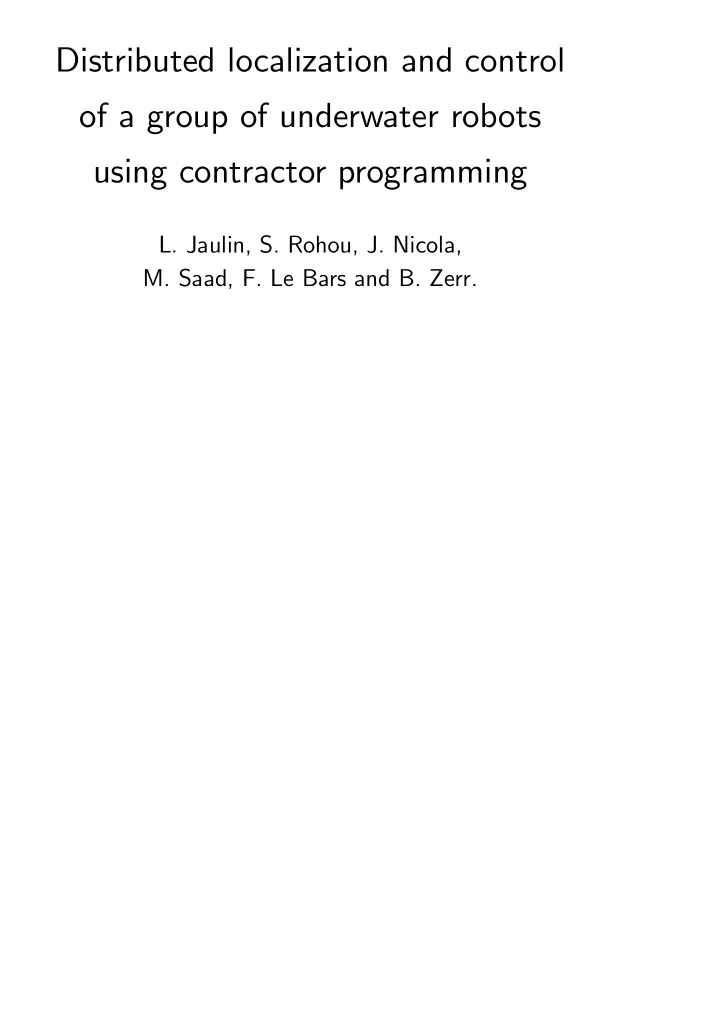

Distributed localization and control of a group of underwater robots using contractor programming L. Jaulin, S. Rohou, J. Nicola, M. Saad, F. Le Bars and B. Zerr.
SWIM’15 Prague, June 9-11, 2015 ENSTA Bretagne, OSM, LabSTICC. Video of the presentation https://youtu.be/q6F7WDCcf2A
1 Scout project
Goal : (i) coordination of underwater robots ; (ii) collabo- rative behavior.
Supervisors : L. Jaulin, C. Aubry, S. Rohou, B. Zerr, J. Nicola, F. Le bars Compagny : RTsys (P. Raude) Students : G. Ricciardelli, L. Devigne, C. Guillemot, S. Pommier, T. Viravau, T. Le Mezo, B. Sultan, B. Moura, M. Fadlane, A. Bellaiche, T. Blanchard, U. Da rocha, G. Pinto, K. Machado.
2 Controller
3 Localization problem
Range only Based on interval analysis Robust with respect to outliers Distributed computation Low rate communication We propose here to use a contractor programming ap- proach
4 Matrices and contractors
linear application matrices → � � � α = 2 a + 3 h 2 3 L : → A = γ = h − 5 a 1 − 5 We have a matrix algebra and Matlab. We have: var ( L ) = { a, h } , covar ( L ) = { α, γ } . But we cannot write: var ( A ) = { a, h } , covar ( A ) = { α, γ } .
constraint → contractor a · b = z →
Contractor fusion � a · b = z → C 1 b + c = d → C 2 Since b occurs in both constraints, we fuse the two con- tractors as: C = C 1 × C 2 ⌋ (2 , 1) = C 1 |C 2 (for short)
5 Localization with contractors
x j h +1 = f ( x j h , u j h ) , h ∈ { k − ¯ h, . . . , k } = � The observer: C k,j h,...,k } C j x h ∈{ k − ¯ x ( h ) � � var ( C k,j x ) = var ( C k,j x j h , . . . , x j k , x j x ( h ) ) = . k − ¯ k +1
z j h = h ( x j h ) � � x ∩ � { q 1 } Observer RSO: C k,j x ,z = C k,j C k,j x | C h,j . z h ∈{ k − ¯ h,...,k }
To get an outer approximation of set ( C k,j x ,z ) , we need a paver. We can also obtain an inner approximation using separators [SMART 2015].
t = 0
t = 0 . 1
t = 0 . 2
t = 0 . 3
t = 0 . 4
t = 0 . 5
t = 0 . 6
t = 0 . 7
t = 0 . 8
t = 0 . 9
t = 1 . 0
t = 1 . 1
t = 1 . 2
t = 1 . 3
t = 1 . 4
6 Distributed localization
y j,ℓ h = g ( x j h , x ℓ h )
Observer: � � � { q 1 } C k,j = C k,j C k,j x | C h,j ∩ x ,z x z h ∈{ k − ¯ h,...,k } � � � { q 2 } C k,j x | C h,j,ℓ ∩ y h ∈{ k − ¯ h,...,k }
7 Singularity
8 Test case
QT/C++ code available at http://www.ensta-bretagne.fr/jaulin/easibex.html
9 Tests
Recommend
More recommend